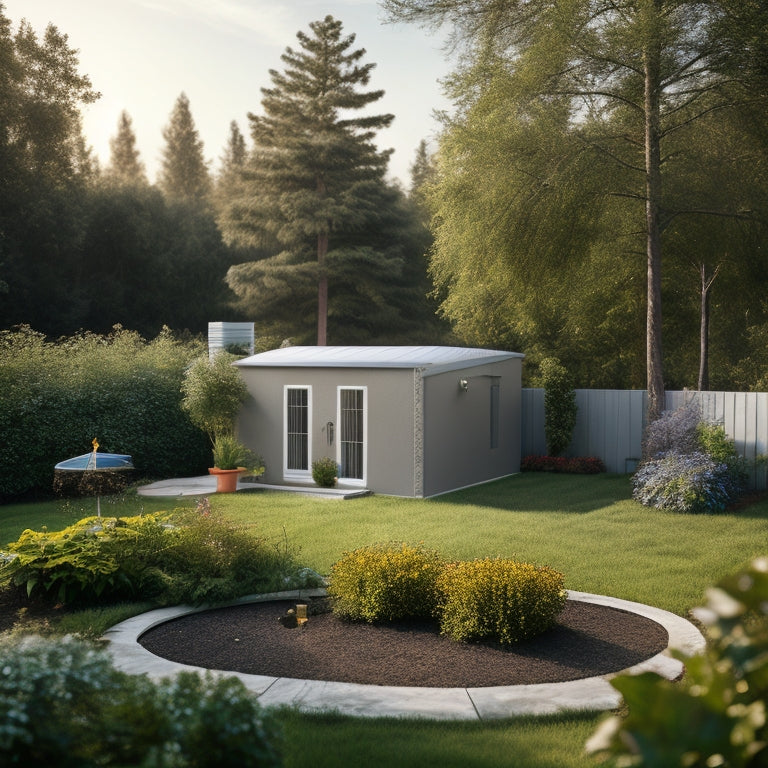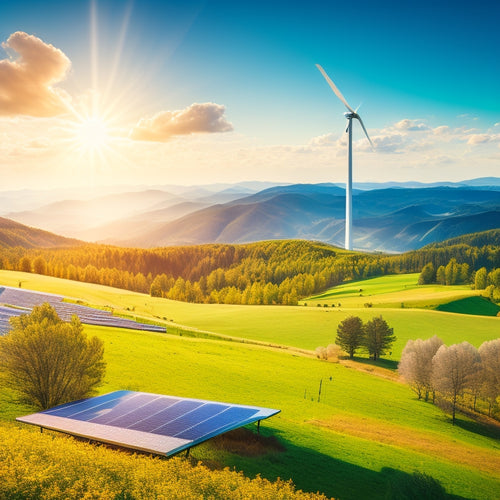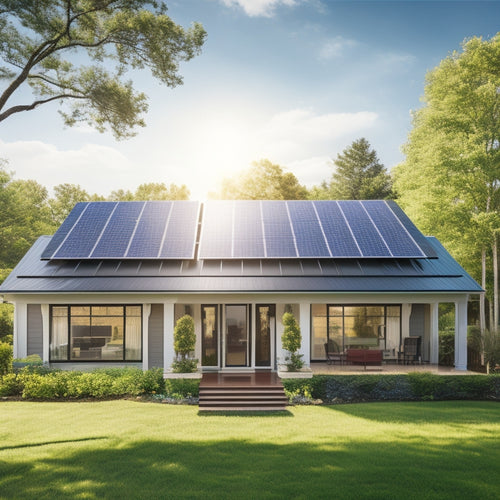
Small Panels for Home Energy Independence
Share
With small solar panels, you can utilize the power of renewable energy to reduce your reliance on the grid, lower your energy bills, and contribute to a cleaner environment, especially in urban settings or homes with limited roof space. Compact systems like portable solar panels are ideal for rooftops, offering flexible installation options for various home designs. By selecting the right solar kit and energy storage solutions, you can power household appliances directly, reducing your grid reliance and energy costs. As you investigate the world of small solar panels, you'll uncover how to maximize energy harvesting and storage, and access the full potential of energy independence for your home.
Overview
- Compact small solar panels are ideal for rooftops with limited space, offering flexible installation options for various home designs.
- High-efficiency solar panels optimize energy harvesting, contributing to a cleaner environment and reducing reliance on the grid.
- Reliable energy storage systems, like solar batteries, ensure power availability during low sunlight and enhance overall system efficiency.
- Proper energy management systems integrate with solar panels to optimize energy usage, reduce costs, and increase home energy independence.
- Small solar panels can increase home value, offer tax credits and incentives, and contribute to a sustainable future with renewable energy.
Small Solar Panels for Homes
You're considering small solar panels for your home, a great step towards energy independence. Compact systems like portable solar panels can be easily installed on your rooftop, providing a reliable source of renewable energy.
With grid independence, you'll reduce your reliance on the grid and lower your energy bills. Many solar kits, such as the WindyNation Complete Kit, offer exceptional solar performance and easy installation high-efficiency solar panels optimized for maximum energy harvesting.
Look for energy-efficient systems with high-quality solar monitoring to maximize your energy output. By adopting sustainable living practices, you'll be contributing to a cleaner environment and enjoying eco-friendly solutions.
Renewable technology has come a long way, making it easier for homeowners like you to shift to a greener lifestyle.
Powering Appliances With Solar
You're likely wondering how to power your appliances with solar energy, and it all starts with understanding how solar power for homes works.
When selecting a solar panel system, take into account top-rated solar battery brands like Tesla and LG for reliability and durability.
You'll need to take into account the amount of energy your appliances require and how that translates to the size of your solar panel system.
Additionally, you'll want to investigate energy storage options, such as batteries, to guarantee you have power when the sun isn't shining.
Solar Power for Homes
Most homeowners considering solar power for their homes wonder if it's possible to power their appliances directly with solar energy. The answer is yes!
With advances in solar technology, you can utilize the sun's energy to power your appliances, reducing your reliance on the grid and minimizing your environmental impact. By embracing independence through solar power systems, you can reduce your carbon footprint and contribute to a more sustainable future.
Solar incentives and renewable financing options make it more affordable than ever to go solar. Plus, with energy-efficient appliances and home automation, you can optimize your energy consumption and maximize your savings.
While installation costs are a consideration, maintenance tips can help you get the most out of your system. By choosing solar power, you're taking a step towards grid independence and sustainable living.
Energy Storage Options
Now that you've made the decision to power your appliances with solar energy, it's time to contemplate how to store that energy for later use.
You'll need a reliable energy storage system to guarantee your home remains powered during periods of low sunlight or at night. Advances in battery technologies have made energy storage more efficient and cost-effective.
You can choose from a range of options, including lead-acid, lithium-ion, and saltwater batteries.
Effective energy management is essential to optimize your energy storage. You'll need to monitor your energy production and consumption to make sure you're storing excess energy for later use.
With the right energy storage system and management strategy, you'll be well on your way to achieving home energy independence.
Choosing the Right Solar Kit
Your rooftop is ready to harness the sun's energy, and it's time to select the ideal solar kit to make that happen.
You'll want to choose a kit that suits your energy needs and installation requirements. There are two primary solar kit types: grid-tie and off-grid. Grid-tie kits connect to the grid, allowing you to sell excess energy back to the utility company. Off-grid kits are ideal for remote locations or those seeking complete energy independence.
Consider factors like panel wattage, voltage, and compatibility with your energy storage system. Confirm the kit meets local building codes and regulations.
Carefully review the installation requirements, including roof size, orientation, and shading considerations. By selecting the right solar kit, you'll be well on your way to achieving energy independence.
DIY Solar Installation Tips
As you prepare to tackle the installation of your solar kit, guaranteeing a safe and efficient process is vital.
Begin by securing necessary installation permits and adhering to local building codes. Next, assess your energy needs and determine whether an off-grid system or grid-tied option is best for you.
Proper battery management is essential for peak performance and longevity. Don't forget to take into account solar incentives, which can greatly offset your investment.
During installation, prioritize energy efficiency and minimize environmental impact.
Finally, familiarize yourself with solar panel maintenance best practices to guarantee your system runs smoothly for years to come.
Maximizing Energy Harvesting
You'll want to enhance your panel angle to match your location's latitude, ensuring maximum energy absorption.
By utilizing peak sunlight, typically between 9 am and 3 pm, you can considerably increase your energy yield.
To achieve this, consider adjusting your panel's tilt and orientation to capture the sun's rays at the ideal angle.
Optimize Panel Angle
Positioned at the correct angle, solar panels can greatly enhance energy harvesting. You can maximize panel performance by adjusting the angle to match your location's latitude. This guarantees maximum solar efficiency, resulting in more energy harvested.
| Latitude Range | Ideal Panel Angle | Seasonal Adjustment |
|---|---|---|
| 0°-23° | 15°-25° | ±5° |
| 24°-42° | 20°-30° | ±10° |
| 43°-51° | 25°-35° | ±15° |
| 52°-60° | 30°-40° | ±20° |
| 61°-90° | 35°-45° | ±25° |
Harness Peak Sunlight
By optimizing the panel angle, you've taken the first step toward maximizing energy harvesting.
Now, it's time to utilize peak sunlight to enhance your solar efficiency. Peak sunlight hours typically occur between 9 am and 3 pm, when the sun is highest in the sky.
To capitalize on this, make certain your panels receive direct sunlight during these hours. Consider trimming trees or removing obstructions to minimize shading.
Additionally, adjust your panel's tilt to match the seasonal sun angle. By doing so, you'll increase your energy yield and reduce reliance on the grid.
Boost Energy Yield
How can you squeeze every last kilowatt-hour from your solar panels? To maximize energy harvesting, you need to focus on energy efficiency. This means enhancing your system's performance to get the most out of your small panels. Here are some key factors to take into account:
| Factor | Impact | Action |
|---|---|---|
| Panel Angle | 10-20% | Adjust panels seasonally for ideal sun exposure |
| Shading | 5-10% | Trim trees, remove obstructions, or use shading mitigation |
| Inverter Efficiency | 5-10% | Choose a high-efficiency inverter for your system |
Storing Excess Solar Energy
What happens to the excess energy your solar panels generate on sunny days when your home isn't using it all? You can store it for later use with a solar battery.
This battery is a key component of your energy management system, allowing you to utilize the power of the sun even when it's not shining. By storing excess energy, you can reduce your reliance on the grid and enjoy true energy independence.
A solar battery can also provide backup power during outages, keeping your lights on and your fridge running.
With a well-designed energy management system, you can optimize your energy usage and make the most of your solar panels' output.
Frequently Asked Questions
Can I Install Solar Panels on a Metal or Clay Tile Roof?
You can install solar panels on a metal or clay tile roof, but you'll need to guarantee your roof's suitability by checking installation requirements, such as structural integrity, waterproofing, and compatibility with panel mounting systems.
Do Solar Panels Generate Power During a Blackout?
Imagine being an island, self-sufficient and unaffected by the mainland's power outages. During a blackout, your solar panels won't generate power directly, but with solar battery storage, you'll have a backup plan, ensuring blackout safety and energy freedom.
Can I Use Solar Power for My Electric Vehicle Charging?
You can utilize solar power for electric vehicle charging, reducing your reliance on the grid; with a solar charging system, you'll generate clean energy to fuel your EV, giving you more autonomy and freedom on the road.
How Do I Maintain and Clean My Solar Panels?
You'll guarantee ideal energy harvesting by performing regular solar panel maintenance, including inspecting for debris, and employing gentle cleaning techniques like soft-bristled brushes and distilled water to remove dirt and grime, enhancing your energy independence.
Are Solar Panels Resistant to Hail and Extreme Weather?
You'll be relieved to know that most solar panels are designed to withstand extreme weather, including hail damage, thanks to rigorous testing and certification standards, so you can rest easy knowing your investment is protected.
Ready to Buy
You've taken the first step towards home energy independence by utilizing solar power. Research suggests that decentralized energy systems, like small solar panels, can increase energy resilience by 20% (according to a study by the National Renewable Energy Laboratory). By following these DIY installation tips and maximizing energy collection, you'll be well on your way to reducing your reliance on the grid. Now, it's time to monitor your system's performance and make adjustments as needed to achieve ideal energy independence.
Related Posts
-

Renewable Energy Solutions to Reduce Your Carbon Footprint
To reduce your carbon footprint, adopting renewable energy solutions is key. Using solar panels or wind turbines can ...
-

Why Outdoor Solar Lighting Systems Are Sustainable
Outdoor solar lighting systems are sustainable because they utilize renewable energy, drastically reducing your carbo...
-

Home Solar Installation Cost
You're considering installing solar panels on your home, and the upfront cost is likely the biggest hurdle standing i...


